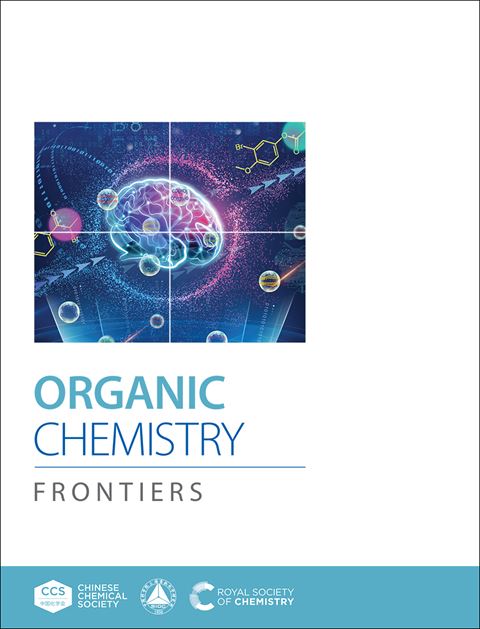超越能量转移:基态结合驱动的[2+2]环加成与吲哚-融合有机光催化剂
IF 4.7
1区 化学
Q1 CHEMISTRY, ORGANIC
引用次数: 0
摘要
介绍了我们实验室开发的一种使用吲哚融合有机光催化剂(organoPCs)的可见光驱动[2+2]环加成策略,强调了一种以最小溶剂使用量和无牺牲试剂的可持续方法。由光谱分析和密度泛函理论(DFT)计算支持的机理研究表明,这种转变是通过基态关联机制进行的,而不是更常见的能量转移途径。具体来说,有机opc和肉桂酸底物之间的非共价相互作用使[PC···底物]复合物能够形成,该复合物在光激发下有效地进入三重态,从而驱动[2+2]环加成。有机opc框架的结构调整对催化性能至关重要,因为具有扩展π共轭的五环结构显示出增强的π -π相互作用和优越的反应性。这种设计原则有利于在广泛的功能化肉桂酸衍生物中进行区域选择性环添加,突出了在可见光照射下可实现的多功能性和原子经济性。本文章由计算机程序翻译,如有差异,请以英文原文为准。
Beyond Energy Transfer: Ground-State Association-Driven [2+2] Cycloadditions with Indole-Fused Organophotocatalysts
A visible-light-driven [2+2] cycloaddition strategy with indole-fused organophotocatalysts (organoPCs) developed in our laboratory is presented, highlighting a sustainable approach with minimal solvent usage and no sacrificial reagents. Mechanistic investigations, supported by spectroscopic analyses and density functional theory (DFT) calculations, suggest that this transformation proceeds via a ground-state association mechanism rather than the more commonly proposed energy transfer pathway. Specifically, noncovalent interactions between the organoPC and a cinnamate substrate enable the formation of a [PC···substrate] complex, which, upon photoexcitation, engages in an efficient route to the triplet state that drives [2+2] cycloaddition. Structural tuning of the organoPC framework proves critical to catalytic performance, as pentacyclic architectures featuring extended π-conjugation display enhanced π–π interactions and the superior reactivity. This design principle facilitates regioselective cycloadditions across a broad range of functionalized cinnamate derivatives, highlighting the versatility and atom economy achievable under visible-light irradiation.
求助全文
通过发布文献求助,成功后即可免费获取论文全文。
去求助
来源期刊

Organic Chemistry Frontiers
CHEMISTRY, ORGANIC-
CiteScore
7.90
自引率
11.10%
发文量
686
审稿时长
1 months
期刊介绍:
Organic Chemistry Frontiers is an esteemed journal that publishes high-quality research across the field of organic chemistry. It places a significant emphasis on studies that contribute substantially to the field by introducing new or significantly improved protocols and methodologies. The journal covers a wide array of topics which include, but are not limited to, organic synthesis, the development of synthetic methodologies, catalysis, natural products, functional organic materials, supramolecular and macromolecular chemistry, as well as physical and computational organic chemistry.
 求助内容:
求助内容: 应助结果提醒方式:
应助结果提醒方式:


